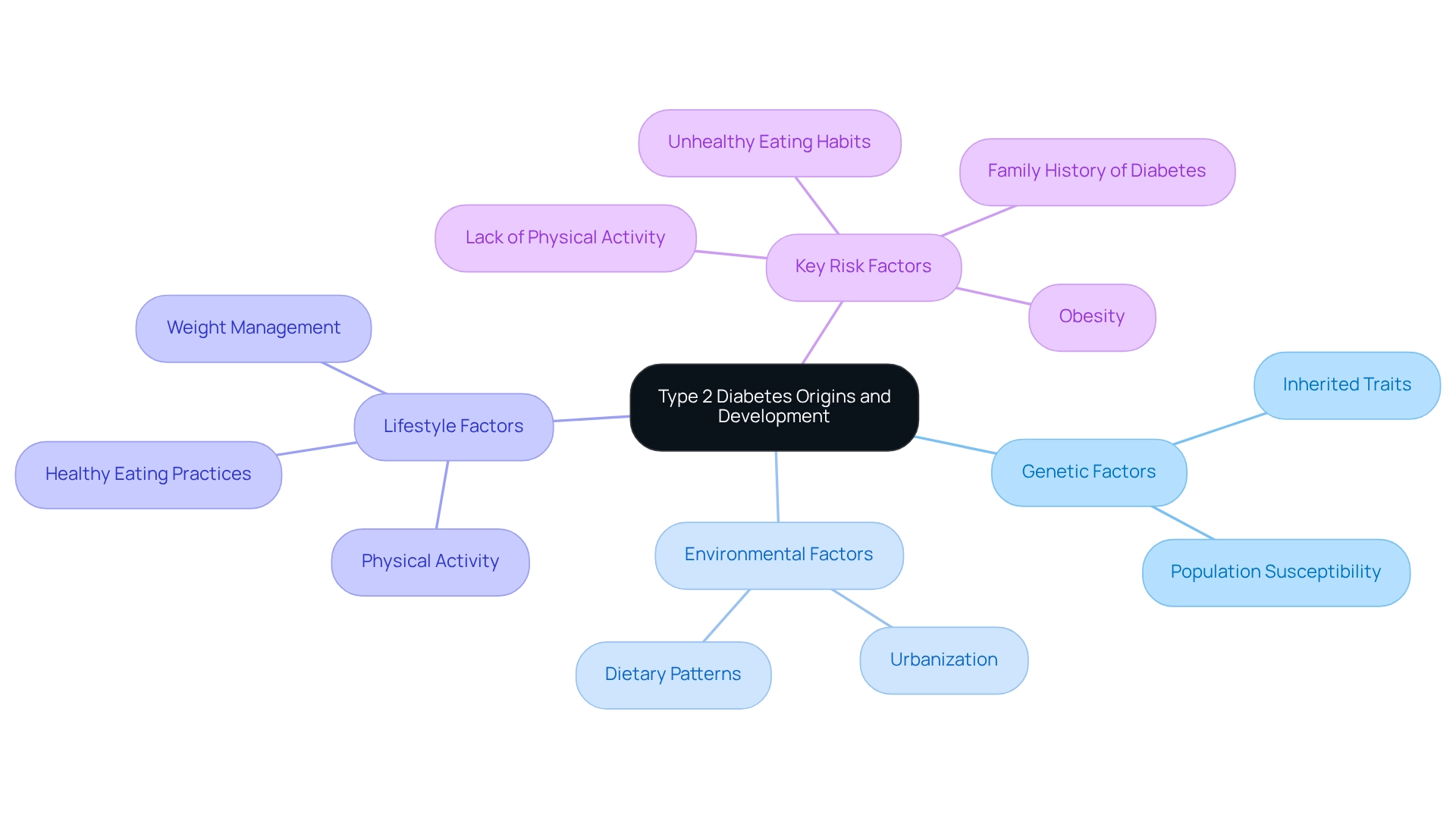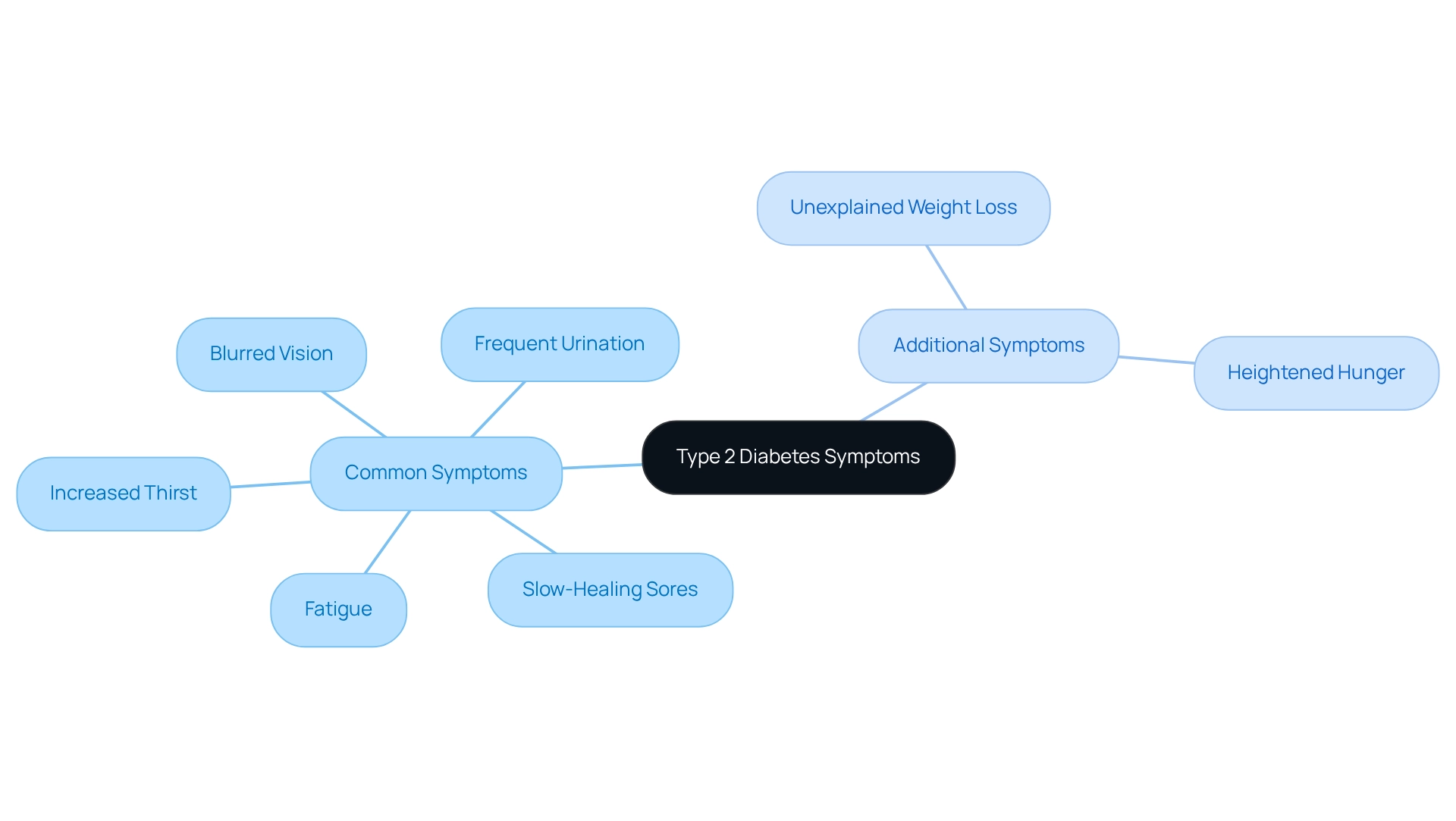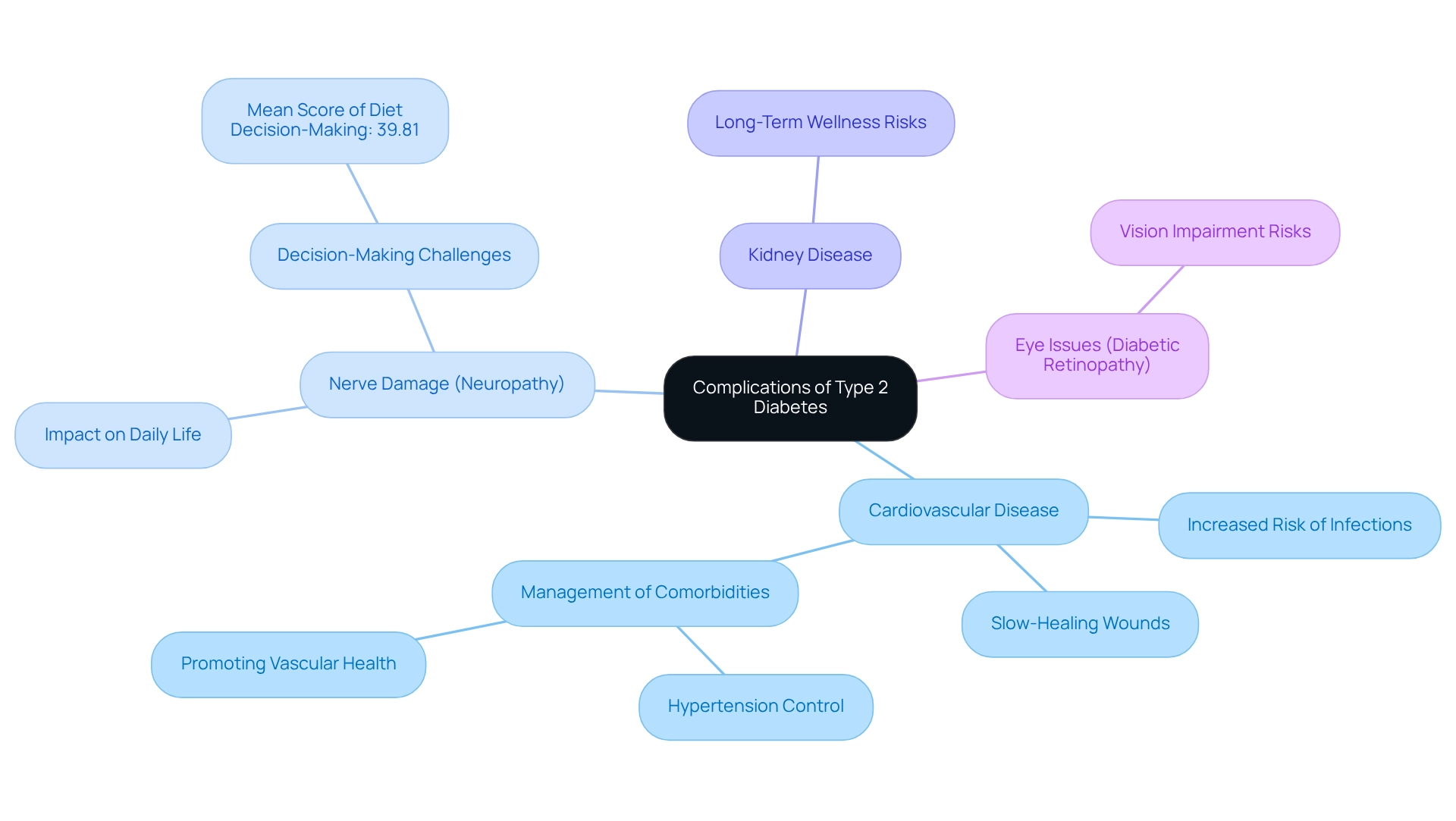Overview
This article gently explores the manifestations of Type 2 diabetes, a condition often marked by insulin resistance and elevated blood glucose levels. It’s important to understand that these issues are frequently linked to obesity and a sedentary lifestyle. Recognizing the symptoms and complications of Type 2 diabetes is crucial, as is learning about effective management strategies.
As we delve into this topic, we want to emphasize that you are not alone in this journey. Many individuals face similar challenges, and understanding the statistics and research surrounding the growing prevalence of Type 2 diabetes can be both enlightening and alarming. It’s essential to acknowledge the associated health risks that this condition poses globally.
We encourage you to seek support and resources that can help you navigate this condition. Remember, it’s understandable to feel overwhelmed, but there are pathways to better health and well-being. Together, we can explore these options and find ways to manage Type 2 diabetes effectively.
Introduction
As the prevalence of Type 2 Diabetes continues to rise at an alarming rate, understanding this chronic condition has never been more crucial. It's understandable to feel overwhelmed by the statistics—millions are affected worldwide, and projections suggest that one in three adults could be impacted by 2050. Characterized by insulin resistance and often linked to lifestyle factors such as obesity and inactivity, Type 2 Diabetes can lead to serious health complications like cardiovascular disease and kidney failure.
Recent research highlights the importance of early detection and effective management strategies, emphasizing how education and lifestyle changes can make a difference. You're not alone in this journey; resources like T2DSolutions are emerging to support individuals facing this diagnosis. Together, we can foster better health outcomes through informed and proactive approaches to diabetes care. Let's take this step forward, knowing that support is available every step of the way.
Define Type 2 Diabetes: Understanding the Condition
The second form of diabetes, which includes manifestations of type 2 diabetes, is a long-lasting metabolic condition that many people face, characterized by insulin resistance and a relative lack of insulin production. This leads to increased blood glucose levels. Unlike the first form of diabetes, where the pancreas does not generate insulin, individuals with the second form can create insulin, but their bodies do not use it efficiently. This condition is often linked to obesity, a sedentary lifestyle, and genetic factors, which can result in manifestations of type 2 diabetes.
It represents the most common manifestations of type 2 diabetes, accounting for roughly 90-95% of all cases globally. Current statistics indicate a concerning trend. Projections suggest that if the present trajectory persists, one in three adults could be impacted by the second form of diabetes by 2050.
It's understandable to feel overwhelmed by this information; recognizing the significance of understanding and tackling this condition is crucial, as it presents substantial risks to well-being, including cardiovascular disease, kidney failure, and neuropathy. In Tunisia, for example, there were 152 Disability-Adjusted Life Years (DALYs) linked to manifestations of type 2 diabetes in 2021, underscoring its global impact.
Recent research emphasizes the crucial role of insulin resistance in the onset of manifestations of type 2 diabetes, stressing the necessity for effective management strategies. Case studies have shown that addressing obesity through public programs and lifestyle changes is vital for preventing the increase of this condition. Furthermore, the annual remission rate for Type 2 Diabetes is estimated to be no more than 1%, illustrating the challenges faced in managing this chronic disease.
As Sir Zumla, a UK-NIHR Senior Investigator, points out, tackling this condition requires immediate focus and additional research funding to create effective prevention strategies, especially in understanding the manifestations of type 2 diabetes, which is essential for millions worldwide. Efficient management can greatly enhance health outcomes and overall well-being.
As T2DSolutions prepares to launch as a comprehensive resource hub for managing this condition and offering community support, we encourage you to subscribe for updates on valuable resources and strategies to effectively handle this issue. Remember, you're not alone in this journey; we are here to support you every step of the way.

Explore the Origins and Development of Type 2 Diabetes
At T2DSolutions, we are dedicated to being a valuable resource hub for diabetes education and management. Understanding the complexities of type 2 diabetes and its manifestations can be overwhelming, but it's important to remember that this condition arises from a combination of genetic, environmental, and lifestyle factors. It typically develops gradually, starting with insulin resistance, where the body's cells become less responsive to insulin. Initially, the pancreas compensates by producing more insulin, but over time, it may struggle to keep up with the body's increasing demands.
Key risk factors include:
- Obesity
- Lack of physical activity
- Unhealthy eating habits
- A family history of diabetes
These factors contribute to the rising prevalence of manifestations of type 2 diabetes, especially linked to increasing obesity levels and inactive lifestyles in developed countries. Recent statistics reveal a significant surge in diabetes cases globally over the past three decades, which poses serious implications for healthcare systems. In Tunisia, for example, the disability-adjusted life years (DALY) count reached 152 (thousands), highlighting the urgent need for effective management strategies to address the manifestations of type 2 diabetes, underscoring the importance of understanding the genetic predispositions that contribute to this condition.
Studies show that genetic factors play a crucial role, with certain populations being more susceptible due to inherited traits. Additionally, environmental influences, such as urbanization and dietary patterns, can further heighten the risk. Sir Zumla, a UK-NIHR Senior Investigator, emphasizes that addressing both genetic and environmental aspects is essential for developing targeted prevention strategies, as real-life examples illustrate how lifestyle changes can help prevent the manifestations of type 2 diabetes.
Individuals who adopt healthier dietary practices, increase physical activity, and maintain a healthy weight often see improvements in insulin sensitivity and overall well-being. The Lancet Commission on diabetes highlights the importance of data-driven methods to inform policy decisions and enhance diabetes treatment, reinforcing the need for lifestyle modifications supported by strong evidence to address the manifestations of type 2 diabetes.
By fostering a deeper understanding of these origins, we can work together—individuals and healthcare professionals alike—to reduce the risks associated with type 2 diabetes, ultimately leading to better health outcomes. This knowledge also aids in recognizing the signs and symptoms of the condition, allowing for earlier intervention and effective management. Remember, you're not alone in this journey; we are here to support you every step of the way.

Identify Key Characteristics and Symptoms of Type 2 Diabetes
Condition 2 is characterized by ongoing hyperglycemia, which can manifest as manifestations of type 2 diabetes through various symptoms. You might notice common indicators that are the manifestations of type 2 diabetes, including:
- Increased thirst
- Frequent urination
- Fatigue
- Blurred vision
- Slow-healing sores
Additionally, some individuals may experience:
- Unexplained weight loss
- Heightened hunger
It's important to note that the manifestations of type 2 diabetes often develop gradually, and a significant percentage of individuals may remain asymptomatic for years, making early detection challenging. In fact, studies suggest that nearly 25% of individuals are unaware of their condition until complications arise from the manifestations of type 2 diabetes. Recognizing these symptoms is crucial. Early diagnosis and management can significantly reduce the risk of complications arising from manifestations of type 2 diabetes.
T2DSolutions serves as a valuable resource hub for newly diagnosed patients, offering education and support to help you understand these symptoms and seek timely medical advice. Studies show that people with manifestations of type 2 diabetes are twice as likely to face depression compared to those who do not have these manifestations. This highlights the importance of incorporating mental wellness support into care for individuals experiencing manifestations of type 2 diabetes.
A case study titled 'Mental Health Challenges in Blood Sugar Conditions' emphasizes this connection, showing that effective management of such conditions must also consider mental well-being to enhance overall health outcomes. This is particularly important given that more than 60 percent of all nontraumatic amputations of lower limbs occur in people with diabetes, highlighting the serious complications, including manifestations of type 2 diabetes, that can arise from unmanaged diabetes.
Healthcare providers stress the importance of regular screening tests to detect early indicators of second-degree diabetes. Prompt intervention can lead to improved management strategies for the manifestations of type 2 diabetes. Recent studies have shown that many patients diagnosed with a certain form of diabetes exhibit common symptoms of manifestations of type 2 diabetes, yet a significant number remain unaware of their condition until complications arise. This underscores the importance of awareness and education regarding the key symptoms to watch for concerning manifestations of type 2 diabetes, ensuring that you can seek help promptly and effectively.
Remember, you're not alone in this journey; we are here to support you every step of the way.

Examine Complications and Variations in Type 2 Diabetes
Complications of type 2 diabetes can be quite severe, impacting various body systems and leading to significant manifestations of type 2 diabetes. Common complications, which are manifestations of type 2 diabetes, include:
- cardiovascular disease
- nerve damage (neuropathy)
- kidney disease
- eye issues like diabetic retinopathy
It's understandable to feel concerned, as statistics indicate that individuals with manifestations of type 2 diabetes face an increased risk of infections and slow-healing wounds, complicating their overall wellness management.
Notably, a study revealed that the mean score of diet decision-making was 39.81 for those experiencing complications and 38.19 for those without. This highlights the decision-making challenges faced by individuals managing the manifestations of type 2 diabetes. Recent studies have also uncovered a troubling link between Type 2 diabetes and cognitive decline, leading to the concept of Type 3 diabetes—characterized by insulin resistance in the brain and its association with Alzheimer's disease. This growing awareness underscores the essential need for effective management strategies to mitigate long-term wellness risks, particularly the manifestations of type 2 diabetes.
Experts emphasize that managing comorbidities, such as hypertension, and promoting vascular health are vital in reducing cardiovascular complications associated with the manifestations of type 2 diabetes. As Habib Jalilian observes, "Managing comorbidities like hypertension and implementing strategies to enhance vascular health can be crucial in diminishing the cardiovascular complications of this condition."
Real-life instances illustrate how individuals navigate these challenges, highlighting the importance of community support and shared experiences in effectively managing the manifestations of type 2 diabetes. T2DSolutions strives to provide a platform for education and support, featuring inspiring personal stories from those managing diabetes, aimed at fostering connection and encouragement among users. By acknowledging the complications that arise from manifestations of type 2 diabetes, patients can take proactive steps toward better health outcomes, supported by the resources available through T2DSolutions. Remember, you're not alone in this journey; we are here to support you every step of the way.

Conclusion
The complexities surrounding Type 2 Diabetes highlight the urgent need for awareness and proactive management. As a chronic metabolic disorder characterized by insulin resistance, its prevalence is alarmingly rising, with projections suggesting that one in three adults could be affected by 2050. Understanding the origins, symptoms, and complications of this condition is essential for fostering better health outcomes and reducing the associated risks of serious health issues such as cardiovascular disease and kidney failure.
Recognizing key symptoms such as increased thirst, frequent urination, and fatigue is crucial for early diagnosis. Many individuals remain unaware of their condition until complications arise, emphasizing the importance of education and regular screening. Resources like T2DSolutions play a pivotal role in supporting individuals newly diagnosed with Type 2 Diabetes, offering crucial information and community support to navigate the challenges of this chronic disease.
Furthermore, addressing lifestyle factors through informed choices can significantly impact the management and prevention of Type 2 Diabetes. With the support of public health initiatives and community resources, individuals can adopt healthier habits that enhance insulin sensitivity and overall well-being. As our understanding of this condition evolves, so too does the necessity for targeted prevention strategies that consider both genetic and environmental influences.
Ultimately, the journey to better health for those affected by Type 2 Diabetes is a collective effort. By fostering awareness, encouraging lifestyle changes, and utilizing available resources, it is possible to mitigate the impact of this condition and improve quality of life. Remember, you are not alone in this journey. Together, through informed action and community support, we can take meaningful steps towards managing Type 2 Diabetes and achieving healthier futures.
Frequently Asked Questions
What is the second form of diabetes?
The second form of diabetes, primarily referring to type 2 diabetes, is a long-lasting metabolic condition characterized by insulin resistance and a relative lack of insulin production, leading to increased blood glucose levels.
How does type 2 diabetes differ from the first form of diabetes?
Unlike the first form of diabetes, where the pancreas does not produce insulin, individuals with type 2 diabetes can produce insulin, but their bodies do not use it efficiently.
What factors are linked to the development of type 2 diabetes?
Type 2 diabetes is often linked to obesity, a sedentary lifestyle, and genetic factors.
What percentage of diabetes cases globally are attributed to type 2 diabetes?
Type 2 diabetes accounts for roughly 90-95% of all diabetes cases globally.
What are the projections for type 2 diabetes prevalence by 2050?
Projections suggest that if current trends continue, one in three adults could be impacted by type 2 diabetes by 2050.
What health risks are associated with type 2 diabetes?
Type 2 diabetes presents substantial health risks, including cardiovascular disease, kidney failure, and neuropathy.
What was the impact of type 2 diabetes in Tunisia in 2021?
In Tunisia, there were 152 Disability-Adjusted Life Years (DALYs) linked to type 2 diabetes in 2021, highlighting its global impact.
What is the significance of insulin resistance in type 2 diabetes?
Insulin resistance plays a crucial role in the onset of type 2 diabetes, emphasizing the need for effective management strategies.
What is the estimated annual remission rate for type 2 diabetes?
The annual remission rate for type 2 diabetes is estimated to be no more than 1%.
What is being done to address type 2 diabetes?
Tackling type 2 diabetes requires immediate focus and additional research funding for effective prevention strategies, particularly in understanding its manifestations.
What resources are available for managing type 2 diabetes?
T2DSolutions is preparing to launch as a comprehensive resource hub for managing type 2 diabetes and offering community support.



